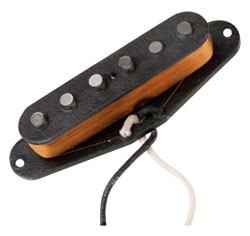As any electric string instrument player knows, there are a number of different types of pickups, and within each category there’s a tremendous variation in possible tone.
This excerpt from The Ultimate Guitar Tone Handbook explains the nine factors that affect how a pickup sounds. The next time you’re in the market for one, keep these in mind so you can better tailor the pickup to your needs.
———————————————-
Just like most things in life, something that seems so simple on the outside is very intricate on the inside and a pickup is no exception. Here are the numerous factors that contribute to a pickup’s sound.
1. The number of turns or winding. This is the number of turns of wire around the bobbin of the pickup. The more turns, the louder the pickup, but the worse the high-frequency response becomes. The number of turns is measured by the electronic resistance of the wire, which is measured in ohms. The higher the ohms value, the hotter the pickup but the less high-frequency response you’ll have. Humbucking pickups have more resistance than a single coil because there are more turns of wire, which is why they’re hotter and have less high end.
2. Type of wire used. The diameter and insulation determines the number of windings that can fit on a bobbin, which will determine the resistance, which determines the output, etc.
3. Type of winding method used. We’ll look at this a bit closer in a bit, but many of the pickups in the early days of the electric guitar were wound by hand, which meant that there were more or less than the required number of windings on the bobbin, and an uneven wind would also affect the capacitance of the pickup, which can cause a peak in the frequency response. This problem was virtually eliminated when manufacturers switched to machine winding, but while every pickup was now the same, some of the magic that occasionally came from a hand-wound pickup also disappeared.
4. The type of magnets used. Although Alnico (a blend of aluminum, nickel and cobalt) is the alloy of choice for most pickups, occasionally you’ll find pickups made of other materials such as ceramic or neodymium. This will affect the strength of the magnetic field.
5. The strength of the magnets used. Magnets used for pickups are categorized by strength on a scale of two to five with five being the strongest. A stronger magnet will produce a louder and brighter sound while a weaker one will produce one that’s warmer.
6. The magnet height. How close the individual magnets are to the strings will determine how loud that string is. On pickups that have adjustable pole pieces that’s not so much of a problem, but on pickups with fixed pole pieces (like a Fender Strat or Tele) that could cause a slight imbalance in the string output. As an example, prior to the late 1960s, most guitarists used a wound G string, so the fixed height of the magnets on a Strat were different to compensate.
7. Pickup cover. Metal covers on humbuckers can cause a resonance that results in feedback problems at high volumes. That’s why many of the early rockers removed their pickup covers, and why many guitars and pickups are sold that way today.
8. Pickup potting. Many pickups are sealed in wax to eliminate vibration induced signals that make a pickup microphonic. The heat from the hot wax can weaken the magnet though, thereby changing the pickup’s sound.
9. Potentiometers. Although not exactly a part of the pickup itself, the volume and tone pots are part of the electronic circuit along with the pickup and can affect the sound. The higher the resistance of the pot, the more high end will pass. Fenders use 250k ohm pots, Gibson uses 500k, and many other manufacturers use 1 Meg pots.
There are other factors such as winding direction, magnetic polarity, and the type of bobbins used, but their contribution to the final sound is subtle at best.
Bobby Owsinski is an author, producer, music industry veteran and technical consultant who has written numerous books covering all aspects of audio recording. For more information be sure to check out his website, and go here to acquire a copy of The Ultimate Guitar Tone Handbook.





















